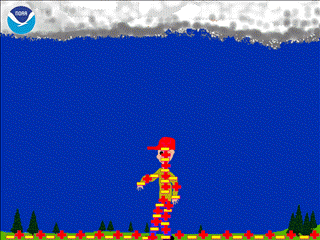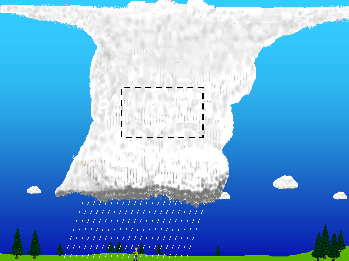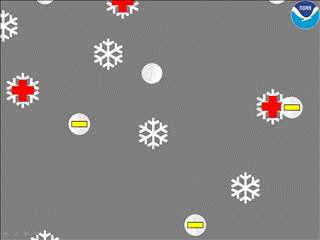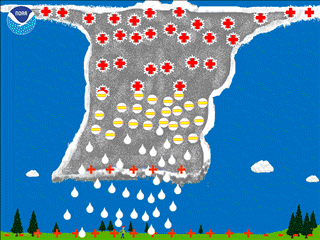While the exact details of the charging process are still being studied, scientists generally agree on some of the basic concepts of thunderstorm electrification. The main charging area in a thunderstorm occurs in the central part of the storm where air is moving upward rapidly (updraft) and temperatures range from -15 to -25 Celsius (Figure 1).
At that place, the combination of temperature and rapid upward air movement produces a mixture of super-cooled cloud droplets (small water droplets below freezing), small ice crystals, and soft hail (graupel). The updraft carries the super-cooled cloud droplets and very small ice crystals upward. At the same time, the graupel, which is considerably larger and denser, tends to fall or be suspended in the rising air. The differences in the movement of the precipitation cause collisions to occur. When the rising ice crystals collide with graupel, the ice crystals become positively charged and the graupel becomes negatively charged (Figure 2).
The updraft carries the positively charged ice crystals upward toward the top of the storm cloud. The larger and denser graupel is either suspended in the middle of the thunderstorm cloud or falls toward the lower part of the storm. The result is that the upper part of the thunderstorm cloud becomes positively charged while the middle to lower part of the thunderstorm cloud becomes negatively charged (Figure 3).
The upward motions within the storm and winds at higher levels in the atmosphere tend to cause the small ice crystals (and positive charge) in the upper part of the thunderstorm cloud to spread out horizontally some distance from thunderstorm cloud base. This part of the thunderstorm cloud is called the anvil. While this is the main charging process for the thunderstorm cloud, some of these charges can be redistributed by air movements within the storm (updrafts and downdrafts). In addition, there is a small but important positive charge buildup near the bottom of the thunderstorm cloud due to the precipitation and warmer temperatures.
The charges on the ground are influenced by the charge build up in the clouds. Normally, the ground has a slight negative charge however, when a thunderstorm is directly overhead, the large negative charge in the middle of the storm cloud repels negative charges on the ground underneath the storm. This causes the ground and any objects (or people) on the ground directly underneath the storm to become positively charged (Figures 4 and 5).
As the negative charge in the cloud increases, the ground responds by becoming more positively charged. Similarly, the positive charge in the anvil can cause a negative charge to build up on the ground under the anvil (which may extend far from the thunderstorm base).
 Figure4 |
 Figure5 |
Learn about Types of Flashes or return to Contents page

Figure 1
Figure 2
Figure3